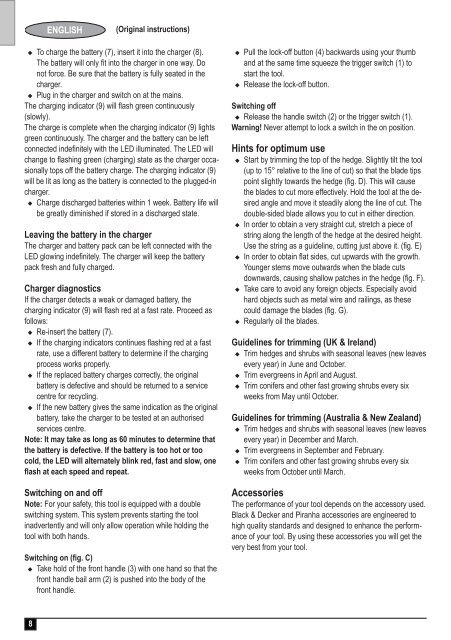BlackandDecker Taille-Haies S/f- Gtc1850n - Type H1 - Instruction Manual (Anglaise)
BlackandDecker Taille-Haies S/f- Gtc1850n - Type H1 - Instruction Manual (Anglaise)
BlackandDecker Taille-Haies S/f- Gtc1850n - Type H1 - Instruction Manual (Anglaise)
Create successful ePaper yourself
Turn your PDF publications into a flip-book with our unique Google optimized e-Paper software.
ENGLISH<br />
(Original instructions)<br />
u To charge the battery (7), insert it into the charger (8).<br />
The battery will only fit into the charger in one way. Do<br />
not force. Be sure that the battery is fully seated in the<br />
charger.<br />
u Plug in the charger and switch on at the mains.<br />
The charging indicator (9) will flash green continuously<br />
(slowly).<br />
The charge is complete when the charging indicator (9) lights<br />
green continuously. The charger and the battery can be left<br />
connected indefinitely with the LED illuminated. The LED will<br />
change to flashing green (charging) state as the charger occasionally<br />
tops off the battery charge. The charging indicator (9)<br />
will be lit as long as the battery is connected to the plugged-in<br />
charger.<br />
u Charge discharged batteries within 1 week. Battery life will<br />
be greatly diminished if stored in a discharged state.<br />
Leaving the battery in the charger<br />
The charger and battery pack can be left connected with the<br />
LED glowing indefinitely. The charger will keep the battery<br />
pack fresh and fully charged.<br />
Charger diagnostics<br />
If the charger detects a weak or damaged battery, the<br />
charging indicator (9) will flash red at a fast rate. Proceed as<br />
follows:<br />
u Re-insert the battery (7).<br />
u If the charging indicators continues flashing red at a fast<br />
rate, use a different battery to determine if the charging<br />
process works properly.<br />
u If the replaced battery charges correctly, the original<br />
battery is defective and should be returned to a service<br />
centre for recycling.<br />
u If the new battery gives the same indication as the original<br />
battery, take the charger to be tested at an authorised<br />
services centre.<br />
Note: It may take as long as 60 minutes to determine that<br />
the battery is defective. If the battery is too hot or too<br />
cold, the LED will alternately blink red, fast and slow, one<br />
flash at each speed and repeat.<br />
Switching on and off<br />
Note: For your safety, this tool is equipped with a double<br />
switching system. This system prevents starting the tool<br />
inadvertently and will only allow operation while holding the<br />
tool with both hands.<br />
Switching on (fig. C)<br />
u Take hold of the front handle (3) with one hand so that the<br />
front handle bail arm (2) is pushed into the body of the<br />
front handle.<br />
u Pull the lock-off button (4) backwards using your thumb<br />
and at the same time squeeze the trigger switch (1) to<br />
start the tool.<br />
u Release the lock-off button.<br />
Switching off<br />
u Release the handle switch (2) or the trigger switch (1).<br />
Warning! Never attempt to lock a switch in the on position.<br />
Hints for optimum use<br />
u Start by trimming the top of the hedge. Slightly tilt the tool<br />
(up to 15° relative to the line of cut) so that the blade tips<br />
point slightly towards the hedge (fig. D). This will cause<br />
the blades to cut more effectively. Hold the tool at the desired<br />
angle and move it steadily along the line of cut. The<br />
double-sided blade allows you to cut in either direction.<br />
u In order to obtain a very straight cut, stretch a piece of<br />
string along the length of the hedge at the desired height.<br />
Use the string as a guideline, cutting just above it. (fig. E)<br />
u In order to obtain flat sides, cut upwards with the growth.<br />
Younger stems move outwards when the blade cuts<br />
downwards, causing shallow patches in the hedge (fig. F).<br />
u Take care to avoid any foreign objects. Especially avoid<br />
hard objects such as metal wire and railings, as these<br />
could damage the blades (fig. G).<br />
u Regularly oil the blades.<br />
Guidelines for trimming (UK & Ireland)<br />
u Trim hedges and shrubs with seasonal leaves (new leaves<br />
every year) in June and October.<br />
u Trim evergreens in April and August.<br />
u Trim conifers and other fast growing shrubs every six<br />
weeks from May until October.<br />
Guidelines for trimming (Australia & New Zealand)<br />
u Trim hedges and shrubs with seasonal leaves (new leaves<br />
every year) in December and March.<br />
u Trim evergreens in September and February.<br />
u Trim conifers and other fast growing shrubs every six<br />
weeks from October until March.<br />
Accessories<br />
The performance of your tool depends on the accessory used.<br />
Black & Decker and Piranha accessories are engineered to<br />
high quality standards and designed to enhance the performance<br />
of your tool. By using these accessories you will get the<br />
very best from your tool.<br />
8
















